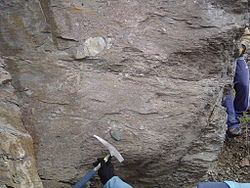- Diamictite
-
Diamictite (pronounced /ˈdaɪ.əmɪktaɪt/, from Greek δια (dia-): through and µεικτός (meiktós): mixed) is a poorly or non-sorted conglomerate or breccia with a wide range of clasts,[1] up to 25% of them gravel sized (greater than 2 cm). Diamictites are composed of coarse, angular to well rounded sedimentary clastic fragments, or other type of fragments (igneous and metamorphic rocks) supported by a typically argillaceous (clay sized) matrix.
The term was coined in 1960 by Flint and others as a purely descriptive term for poorly sorted and laminated rocks, avoiding any reference to a particular origin.[2]
Diamictites are often interpreted mistakenly as having a glacial or ice sheet origin only (see Snowball Earth), while in fact they can be produced by a wide range of different geological mechanisms. Possible origins include:[3][4]
- glacial origin
- meltwater flow deposition
- unsorted moraine glacial till
- basal melt-out
- ice rafted sediments deposited by melting icebergs or disintegrating ice sheets (dropstones)
- volcanic origin
- lahars
- lahar mass flows entering the ocean
- marine origin
- debris flow
- turbiditic olistostromes
- mixing of sediments by submarine landslides
- tectonic origin
- erosional origin
- regolith, in the form of a debris flow
- other mass wasting events
- extraterrestrial origin
The most common origin of diamictites is deposition by submarine mass flows like turbidites and olistostromes in tectonically active areas.[3]
References
- ^ Hallsworth, C.R., Knox, R.W.O'B.: Classification of sediments and sedimentary rocks. British Geological Survey, Research Report RR 99-03, p. 6. (pdf 470 Kb)
- ^ Flint, R.F., Sanders, J.E., Rodgers, J. : Diamictite, a substitute term for symmictite. Geol. Soc. Am. Bull. 71, 1809–1810, 1960.
- ^ a b Eyles, N.; Januszczak, N. (2004). "’Zipper-rift’: A tectonic model for Neoproterozoic glaciations during the breakup of Rodinia after 750 Ma". Earth-Science Reviews 65 (1-2): 1-73. (pdf 4 Mb)
- ^ Huber, H., Koeberl, C., McDonald, I., Reimold, W.U.: Geochemistry and petrology of Witwatersrand and Dwyka diamictites from South Africa: Search for an extraterrestrial component. Geochimica et Cosmochimica Acta, Vol. 65, No. 12, pp. 2007–2016, 2001. (pdf 470 Kb)
Further reading
- Deynoux, M., et al. (Editors) (2004) Earth's Glacial Record, Cambridge University Press, pp. 34–39 ISBN 0-521-54803-9
External links

This article related to petrology is a stub. You can help Wikipedia by expanding it. - glacial origin



